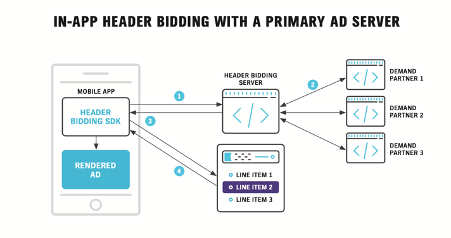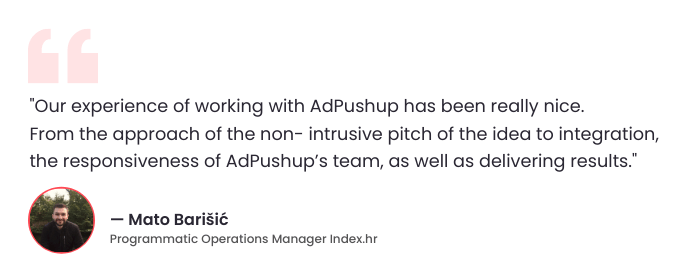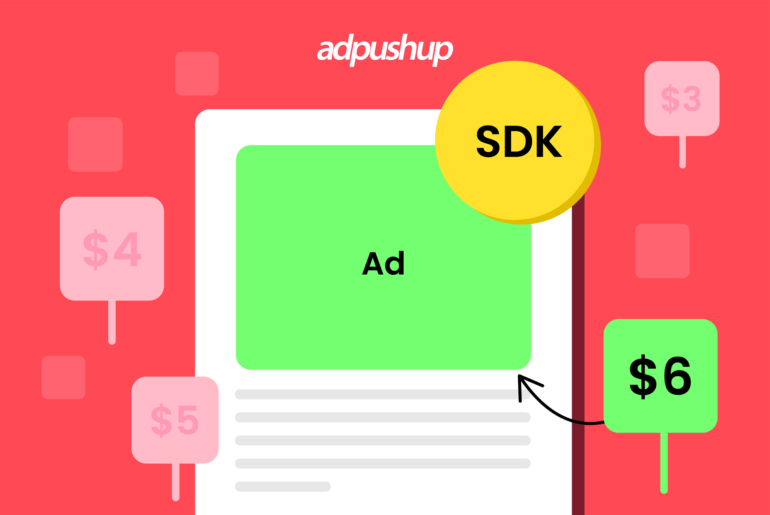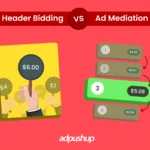In app header bidding is a programmatic advertising technique which allows app owners to monetize their apps and earn better ad revenue. In this blog, we will delve deeper into in app header bidding to help publishers make the best out of it.
Many publishers face a harsh reality: their apps are brimming with potential, but they struggle to capture their full advertising value. In-app header bidding emerges as a transformative solution in this dynamic environment.
Not many app publishers make money from the visitors to their apps, despite the fact that mobile app revenue is on track to hit a whopping $935 billion in 2025
In this blog, we’ve explained why you should leverage in-app header bidding to scale your app’s revenue.
What is In App Header Bidding?
Integrated inside an app’s software development kit, in-app header bidding is a programmatic advertising technique that allows app owners to monetize their content Integrated inside an app’s software development kit, in-app header bidding is a programmatic advertising technique that allows app owners to monetize their content with ads. In-app advertising follows the same principles as traditional header bidding used on websites, including video header bidding. Just like with web-based auctions, every impression goes through a single auction process, where publishers receive the highest bid—thanks to the efficiency of header bidding!
How Does In App Header Bidding Work?
First off, the publisher’s ad stack and demand partners establish a server-to-server link over which all bids are sent. The key distinction between in-app and online header bidding may be found here: Instead of using an external network like HTTP or HTTPS, this communication happens in-app, directly on your smartphone.
It ensures uniform auction, spurring competition among bidders from various demand sources for each in-app ad impression and eventually choosing the highest offer on each ad impression.

Mechanism of In-App Header Bidding
In terms of mechanics, in-app mobile header bidding differs from a traditional header bidding solution. You use a software development kit (SDK) to initiate the auction rather than an embedded piece of code, as you would with web header bidding.
Following that, the concurrent auction takes place.
The highest bidder contends with direct demand for the right to serve the app user who started the app’s loading. The easiest thing will probably be to learn how in-app mobile header bidding operates.
Before we go any further, here is a little self-plug: )
Adpushup AMP ads have a proven track record of increasing ad revenue by 202%. With our real-time bidding for in-app header bidding and optimized ad placements with A/B testing for ad layouts, you get higher eCPMs, more impressions and increased click-through rates.

Web Header Bidding vs. In-App Header Bidding
In-app header bidding has emerged as a fair and transparent method of selling and purchasing advertising space. It enables all buyers to simultaneously bid on identical ad inventory, and the highest bidder always wins, as opposed to the conventional in-app advertising cascade technique.
This method’s workflow is quite similar to website header bidding. Header bidding wrappers, which are JavaScript elements, are responsible for bid evaluation, ad server communication, and ad calls to the demand partner and are used for website header bidding.
In the end, the real-time auction is always won by the highest bidder, whose advertisement appears on the publisher’s page.
Top Benefits of In-App Header Bidding for Publishers
In-app header bidding has been playing a vital role in revolutionizing the way publishers maximize their ad revenue and streamline their operations. Below, you’ll find more of its benefits.
1. Maximized Ad Revenue
Most importantly, in-app header bidding helps in boosting the ad revenue. With the help of in-app header bidding, publishers can offer their ad inventory to more advertisers. Then, these advertisers pay well to reach their target audiences.
2. Increasing Number of Buyers Mean Higher Bid Matches
As buyers are already paying more to target their audiences, it increases the chances of matching buyers and users to secure those higher bids. Moreover, in-app bidding increases the number of bids showing more ad impressions to potential buyers, which eventually increases the overall revenue.
3. Increased Fill Rates
The fill rate is directly proportional to the number of demand partners participating in auctions. So, being a publisher, you can post as many pop-under ads on your website as you want because these ads don’t consume much space.
4. Beats the Waterfall Method
The waterfall method relies on historical data, but in-app header bidding relies on real-time data. This difference proves that the waterfall method is less effective, as top networks have lower bid values. On the other hand, in-app header bidding creates a fairer system and gives media buyers access to better inventory.
5. High Chances of Remarketing Cookie Matches
Cookie matches allow the ads to be focused on a specific set of audiences, which ensures minimum wastage in ad campaigns. This results in higher CPMs for publishers. In-app header bidding enhances the cookie-matching process. So, when you introduce a variety of demand partners, the chances of cookie matching automatically increase.
In-App Header Bidding Benefits for Advertisers
It is a well-versed fact that in-app advertising benefits publishers, but it helps advertisers, too. Using header tag integrations, advertisers can see what type of inventory is available, allowing them to land premium in-app bidding placements as per their choice. In-app advertising helps advertisers by enhancing their targeting strategies, optimizing ad spending and creating better campaigns. how? Let’s explore
Access To Premium Inventory
Before the introduction of header bidding, i.e. 2015, premium inventory was traded only in private marketplaces, leaving lower-quality inventory for open marketplaces. Mobile header bidding solved this issue by enabling advertisers to view and bid for ad inventory as per their requirements and budgets.
Better Targeting
Using In-app header bidding, advertisers get complete insights of their targeted audience in terms of demographics and impressions. By using this data, advertisers can improve their targeting strategies and reach their target audience more efficiently.
Ability to bid across multiple channels
In-app header bidding allows advertisers to simultaneously bid on several channels or apps at once, improving the bidding process and the chances of securing premium ad placements.
How to Set Up In App Header Bidding?
Before you proceed to implement in-app header bidding, make sure that you have a mobile app compatible with Android and iOS and available on the respective app stores.
Then, you need to follow these steps to set up in-app header bidding for your app:
- Choose a header bidding solution.
- Integrate the required header bidding SDKs that may include Prebid SDK, Google IMA SDK, and more.
- Set up the Prebid server and your primary ad server.
- Next, set up demand partners.
- Finally, set up your ad inventory.
- Start testing and optimizing.
Note that, you should know how these elements operate together. Moreover, don’t proceed with the technical setup method if you don’t have any ad-tech experience, tech knowledge, and access to the necessary platforms.
How to Choose an In-App Advertising Solution?
Choosing which SDKs and mediation partners to utilize when implementing header bidding in your app is the difficult part. Mobile app publishers have access to a plethora of mediation partners and SDKs, each of which claims to have its own proprietary ad technology that will produce superior results. None of these can be accurate.
How do you decide then?
Choose a companion who will take care of most things for you. Certain platforms do really have access to reliable demand sources. Others provide a solution that is more or less turnkey and can prevent technical difficulties. However, the platform that does it all is the one for you when you find it.
Key Takeaways
- In-app header bidding generates bids automatically from multiple demand partners by listing mobile publishers’ inventory across various ad networks.
- Similar to web-based header bidding, during In-app bidding, the highest bidder wins the real-time auction.
- In-app header bidding benefits publishers with better revenue, higher bids, increased fill rates and high chances of remarketing cookie matches.
- For advertisers, in-app header bidding allows them access to premium ad inventory and promotes better targeting for their ad campaigns.
- Opt for a Header Bidding platform offering reliable demand sources and minimizing technical challenges. Adpushup is a turnkey solution that can help you maximize your app’s monetization potential.
Frequently Asked Questions: In App Header Bidding
In App Header bidding works on the same principles as header bidding for websites. Instead of relying on the website header in the source code, in app header bidding utilized SDK to generate ad requests for the publishers’ app.
In ad bidding, “app” refers to mobile apps like games or social media. In-app bidding is an auction for ad space within those apps, deciding which ad users see. It helps app creators make money and advertisers reach phone users.
Bids enable people to buy products and services at auctions and other places. It is a competitive procedure in which two or more entities strive to outbid each other by increasing the price they are prepared to pay to get the asset.
Buyers may see a publisher’s whole inventory with a header bidding code, giving them a greater knowledge of their reach. It also provides buyers access to additional audiences and a better probability of delivering campaigns because bid requests may be issued for every possible impression.
It differs from standard real-time bidding (RTB) auctions in that, In place of each ad exchange holding their corresponding auctions at a considerably less priority in the publisher’s ad server, in header bidding, all the ad exchanges are allowed simultaneously at the highest priority in the ad server.









